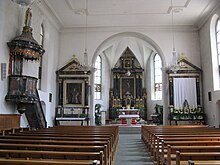City Church Mellingen
The Stadtkirche Mellingen is the Roman Catholic parish church in Mellingen in Switzerland . It is located at the southeast end of the old town, opposite the Iberghof and near the banks of the Reuss . The church dedicated to John the Baptist dates back to the 10th century. The baroque building that exists today was built in 1675, and the Gothic church tower from the 14th century has been preserved.
history
The oldest documented mention of it comes from the year 1045. The town church has been a separate church of the Counts of Lenzburg since at least the 10th century . In the 11th century it became the property of the Schänis Monastery , which Pope Alexander III. confirmed in 1178. A clergyman is first mentioned by name in 1248. In the 13th century the Habsburgs acted as collators , from 1415 the city was responsible for the church. The Mellingen parish converted to the Reformation in 1529 , but was forcibly re-Catholicized three years later after the Second Kappel War . The urban area on the right side of the Reuss , the so-called Trostburger Zwing, belonged to the Rohrdorf parish for centuries and only became part of the Mellingen parish in 1896.
In the late 13th or early 14th century, the Habsburg collators had the medieval, presumably Romanesque , church building replaced by a new Gothic building. Although this was extensively renovated between 1629 and 1632, it turned out to be dilapidated a few decades later. On May 5, 1674, the Small and Large Council of the City of Mellingen decided to demolish the church and turn it 90 degrees to rebuild it in larger dimensions. Work began in March 1675, followed by the inauguration by the auxiliary bishop of Constance in autumn 1676 . From the old church only the tower remained. From 1829 to 1835 the interior was completely redesigned in a classical style, and neo-baroque style elements were added in 1911/12 . Exterior renovations take place in 1959/61 and 2002. Between 1970 and 1972, the classicist interior was restored.
building
The building consists of a rectangular nave 23.5 meters long and 14 meters wide as well as a slightly recessed semi-polygonal choir with a side length of 5 meters. A two-story sacristy is attached to the choir . A hexagonal roof turret with an onion dome rises above the choir . A remnant of the city wall connects the city church with the Iberghof .
The front is decorated with a structure at the ridge end with a stone cross and dial as well as the chiselled main portal from 1675. The latter consists of a pillar-supported round arch, fluted pilasters and a triangular gable with a coat of arms relief (double coat of arms of the city and crowned imperial eagle ). The door leaves are decorated with figurative, ornamental carvings by the artist Johann Adam Widerkehr.
The free-standing square church tower rises a step in front of the north-eastern longitudinal wall of the nave and is connected to the rest of the building by overlapping eaves . The tower was once on the same axis as the previous Gothic building, today it lies across the ridge of the nave roof. In 1973 the tower choir was transformed into a baptistery. It contains a tabernacle from 1583 and a fragmentary cycle of frescoes from the late 14th century. The upper floors of the tower can be reached from the roof ridge of the main building via a covered walkway. In it hangs a 5-part bell that was cast by Rüetschi in Aarau in 1959. The Sebastian bell stands in front of the tower. A bell, also cast in 1959, hangs in the roof turret and can be rung from the choir using a cable.
The classicist style, reconstructed in 1972, dominates the interior, only the choir arch is reminiscent of the earlier Baroque design. The high altar tapering towards the top was painted by Kaspar Moos in 1831 and shows a crucifixion scene ; the altar table dates from 1675. The altar retable is flanked by two wooden sculptures that Johann Adam Widerkehr made in 1677; the left represents John the Baptist , the right John the Evangelist .
The side altars have Renaissance paintings by an unknown painter with a strong Italian influence. They date from around 1600/20, were acquired and used in the art trade in 1972. A 14-part cycle of coats of arms and status disks from the years 1629/31 was taken over from the previous church and has adorned the windows of the nave and choir since 1675.
literature
- Peter Hoegger: The art monuments of the canton of Aargau . Ed .: Society for Swiss Art History . Volume VI, District of Baden I. Birkhäuser Verlag, Basel 1976, ISBN 3-7643-0782-X , p. 399-417 .
Web links
Coordinates: 47 ° 25 '4.8 " N , 8 ° 16' 28.6" E ; CH1903: six hundred and sixty-three thousand and eighty-six / 252246




